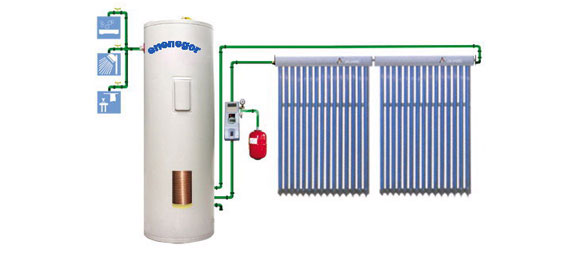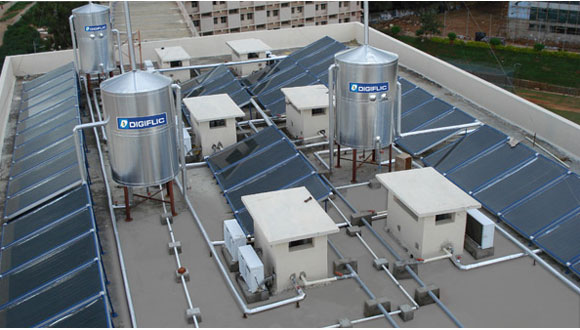If like most people you are worried about rising energy costs and global warming you might be looking into alternative clean energy to heat your home. Solar heating is a clean energy option that should be considered. You may want to start at looking at a solar option to heat your water. From there you can also look into using solar power to heat your entire home.

Thinking about clean energy right now is extremely important. The sun will be there to give us energy for a long time to come. The resources we are currently using; coal, oil, gas, etc… are not renewable and are quickly becoming depleted. Consider making the change today. Start researching different energy sources and look into ways of obtaining them.
How do solar water heating systems work?
Solar water heating systems work in one of 2 ways.
- Direct systems: these systems work by capturing the sun's heat in collectors that heat the home’s water supply. There are collector pipes that are connected to an insulated tank. The sun heats the water in the pipes and the water then flows into the tank. There is maintenance involved with this system; the pipes must be kept clean of all mineral deposits. These systems work better in a climate that is warm throughout the year.
- Indirect systems: These systems use a fluid that has a low freezing point to gather the sun's energy. The heat pipes absorb the heat from the sun and heat up the copper that is on the back of the pipe. There are multiple pipes arranged to maximize the collection of solar energy. Glycol is often used in these systems, it is run through the pipes and heat up when in contact with the copper. Temperature in the pipe will rise and activate a pump that moves the glycol through a coil in the tank. The coil sends the heat to the water tank and hot water is made.

How do solar heating systems work?
To use solar heating for your home the best option is solar heating by fluid. This system uses plate solar collectors to collect energy. If the panels are placed on the roof there are pipes on the top and bottom of the plate that force water through them. This happens continuously until the water is heated. The hot water is sent to a reservoir.
This collector might also be attached to the hot water heater in order to use hot water for laundry, dishes, and bathing. The water is sent from the reservoir into the home. Ideally the water is sent through the floors. This can only be done if the system is designed before the house is built. If installing into an already standing house it can be sent to the baseboards or radiators.
Another way that a home can be heated using solar energy is by installing flat solar panels to collect the heat the water supply and also to heat sand that is under the house. The sand is like a battery holding the energy and gradually releasing it. The problem is it can take a long period of time before the sand becomes charged enough to start releasing the heat to your floors.
This systems advantage is its easy maintenance. It is a system that is totally powered by solar energy and will operate at all times. The problem with this system is there is no control of the settings. Once the sand starts releasing the heat into your floors there is no way to stop it or turn it down.

Solar heating for larger buildings
There is a type of solar heating that uses air. It works best for large buildings. This system uses rubberized tubes that are installed on the roof. The tubes are filled with air that is heated by the sun. The air is taken into the heating system and sent out through heating ducts. This can be turned on as needed and there is no storage system. A large air compressor does the work of sending the air through the pipes.
Cost of systems
The initial cost of a solar heating system can be expensive. Here are some estimates of what the typical costs of installing different types of solar energy for your home are.
1.) Solar energy to save money on water bill: The system will cost under $5000, usually around $3000. This is more than you would pay for a standard water heater, but the system will take about 3 years to pay for it saving 50 to 100% on your water heating bill.
2.) Solar heating: depending on the type anywhere from $3 to $10,000.
3.) Solar energy: turning your home over to solar power can cost upwards of $20,000. Most homes cost between 30 and $40,000 to convert.
Summary:
When choosing solar energy there are a lot of options available. Starting with your water supply is a very easy first step in converting your home to solar power. The water heating system does not cost that much more than a regular system and will save you money in the long term look at things.
Converting to solar heating is also another step. This is easier to do if your house is being built. If you live in an older house there are still options available, they are just not as efficient. Knowing how each system works and amount of money it can save you is very important.
You should look into all sources of clean energy available to you. Don't forget that the government offers significant tax breaks to people willing to convert over to a clean energy source. The federal government will take off up to 30% of the cost of conversion. States also offer different incentives for switching to a clean power source. Do not stop because of the cost. Remember that you are not only saving money over time, you are also saving the planet.